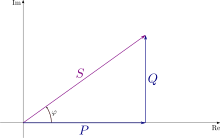Volt-ampere

Apparent power is the magnitude of the vector sum (S) of real (P) and reactive (jQ) AC power vectors
A volt-ampere (VA) is the unit used for the apparent power in an electrical circuit, equal to the product of root-mean-square (RMS) voltage and RMS current.[1] In direct current (DC) circuits, this product is equal to the real power (active power) [2] in watts. Volt-amperes are useful only in the context of alternating current (AC) circuits (sinusoidal voltages and currents of the same frequency).
With a purely resistive load, the apparent power is equal to the real power. Where a reactive (capacitive or inductive) component is present in the load, the apparent power is greater than the real power as voltage and current are no longer in phase. In the limiting case of a purely reactive load, current is drawn but no power is dissipated in the load.
Some devices, including uninterruptible power supplies (UPSs), have ratings both for maximum volt-amperes and maximum watts. The VA rating is limited by the maximum permissible current, and the watt rating by the power-handling capacity of the device. When a UPS powers equipment which presents a reactive load with a low power factor, neither limit may safely be exceeded.[3] For example, a (large) UPS system rated to deliver 400,000 volt-amperes at 220 volts can deliver a current of 1818 amperes.
VA ratings are also often used for transformers; maximum output current is then VA rating divided by nominal output voltage.[4] Transformers with the same sized core usually have the same VA rating.
The convention of using the volt-ampere to distinguish apparent power from real power is allowed by the SI standard.[5]
See also
- AC power
- Volt-ampere reactive
References
^ Ciletti, M. D., Irwin, J. D., Kraus, A. D., Balabanian, N., Bickard, T. A., and Chan, S. P. (1993). Linear circuit analysis. In Electrical Engineering Handbook, edited by R. C. Dorf. Boca Raton: CRC Press. (pp.82–87)
^ IEEE 100 : the authoritative dictionary of IEEE standards terms.-7th ed. .mw-parser-output cite.citation{font-style:inherit}.mw-parser-output .citation q{quotes:"""""""'""'"}.mw-parser-output .citation .cs1-lock-free a{background:url("//upload.wikimedia.org/wikipedia/commons/thumb/6/65/Lock-green.svg/9px-Lock-green.svg.png")no-repeat;background-position:right .1em center}.mw-parser-output .citation .cs1-lock-limited a,.mw-parser-output .citation .cs1-lock-registration a{background:url("//upload.wikimedia.org/wikipedia/commons/thumb/d/d6/Lock-gray-alt-2.svg/9px-Lock-gray-alt-2.svg.png")no-repeat;background-position:right .1em center}.mw-parser-output .citation .cs1-lock-subscription a{background:url("//upload.wikimedia.org/wikipedia/commons/thumb/a/aa/Lock-red-alt-2.svg/9px-Lock-red-alt-2.svg.png")no-repeat;background-position:right .1em center}.mw-parser-output .cs1-subscription,.mw-parser-output .cs1-registration{color:#555}.mw-parser-output .cs1-subscription span,.mw-parser-output .cs1-registration span{border-bottom:1px dotted;cursor:help}.mw-parser-output .cs1-ws-icon a{background:url("//upload.wikimedia.org/wikipedia/commons/thumb/4/4c/Wikisource-logo.svg/12px-Wikisource-logo.svg.png")no-repeat;background-position:right .1em center}.mw-parser-output code.cs1-code{color:inherit;background:inherit;border:inherit;padding:inherit}.mw-parser-output .cs1-hidden-error{display:none;font-size:100%}.mw-parser-output .cs1-visible-error{font-size:100%}.mw-parser-output .cs1-maint{display:none;color:#33aa33;margin-left:0.3em}.mw-parser-output .cs1-subscription,.mw-parser-output .cs1-registration,.mw-parser-output .cs1-format{font-size:95%}.mw-parser-output .cs1-kern-left,.mw-parser-output .cs1-kern-wl-left{padding-left:0.2em}.mw-parser-output .cs1-kern-right,.mw-parser-output .cs1-kern-wl-right{padding-right:0.2em}
ISBN 0-7381-2601-2, page 23
^ Watt Ratings Differs From Volt Amp Ratings APC
^ "Transformers and VA Ratings". 2012-06-27. Retrieved 13 December 2016.
^ "SI Brochure" (8th ed.).

Comments
Post a Comment